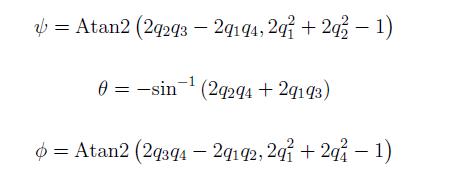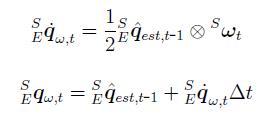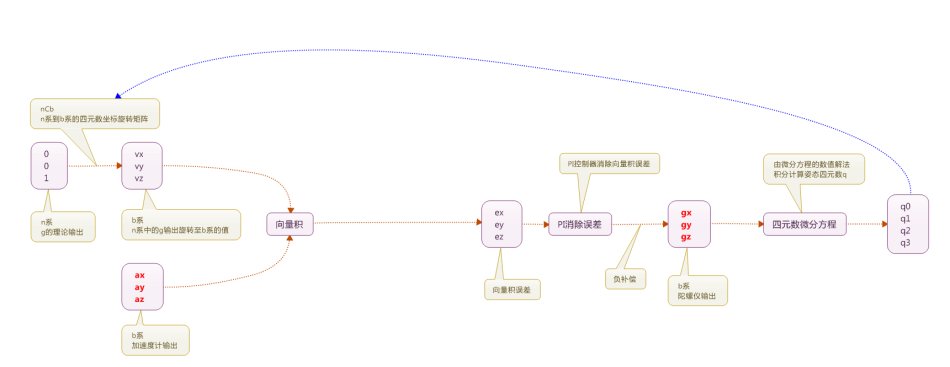四元数及姿态解算 Mahony算法
Posted 大G霸
tags:
篇首语:本文由小常识网(cha138.com)小编为大家整理,主要介绍了四元数及姿态解算 Mahony算法相关的知识,希望对你有一定的参考价值。
AHRS(attitude and heading reference system)称为航姿参考系统。
首先,我们明确一下四元数的知识。
四元数(quaternion)是由我们的威廉·哈密顿提出的。哈密顿就是那个‘哈密顿最小作用原理’的提出者。
四元数可视为复数的扩展。在复数中,定义了,而四元数中则定义了
。也就是说四元数是一个具有三个虚部的虚数。把这些虚部理解为一个复数空间的话,四元数就是一个四位空间。这个是纯数学问题,有兴趣可以了解群论,本人也不是很理解所以也不多讲啦。
但是四元数本身最多的就是使用单位四元数来表示三维空间的旋转(rotation)及定向(orientation)。
为了方便,我们下面使用q = ((x, y, z),w) = (v, w),其中v是向量,w是实数,这样的式子来表示一个四元数。下述内容采自知乎。
首先,定义一个你需要做的旋转。旋转轴为向量,旋转角度为
(右手法则的旋转)。如下图所示:
此图中,

那么与此相对应的四元数(下三行式子都是一个意思,只是不同的表达形式)
这时它的共轭(下三行式子都是一个意思,只是不同的表达形式),
如果你想算一个点在这个旋转下新的坐标
,需要进行如下操作,
1.定义纯四元数
2.进行四元数运算
3.产生的一定是纯四元数,也就是说它的第一项为0,有如下形式:
4.中的后三项
就是
:
这样,就完成了一次四元数旋转运算。
同理,如果你有一个四元数:
那么,它对应一个以向量为轴旋转
角度的旋转操作(右手法则的旋转)。
 是描述了B相对于A的旋转,其中的rx,ry,rz组成的向量也是处于A中的向量。
是描述了B相对于A的旋转,其中的rx,ry,rz组成的向量也是处于A中的向量。 。我们有:
。我们有:

注意,这里的当四元数表示由B相对于A坐标的四元数为 时,他的共轭四元数则表示A相对于B坐标的四元数。
时,他的共轭四元数则表示A相对于B坐标的四元数。
当我们想求相对四元数时,可以使用。详情见笔记11012018A01。

- 封闭性:易证明,p和p的共轭相乘即可,|p*q|=1。
- 结合律:这条也很好证明,只要证明(p*q)*r=p*(q*r)。

更多资料可以参考:https://zhuanlan.zhihu.com/p/28189289
我们下一步来看一下通过陀螺仪输出的角加速度估计姿态问题。
数学操作部分:
如果那些角速度被分配到向量 的时候,即
的时候,即

的时候。
表示传感器所在坐标相对于地磁坐标的姿态改变速率的四元数微分可以表示为下边公式:

 为从E坐标到S坐标的预测值。
为从E坐标到S坐标的预测值。
而在时间t,地球坐标系相对于传感器坐标系的四元数 可以同过
可以同过 的积分获得。而
的积分获得。而 是通过预测值
是通过预测值 与时间t时刻形成的角速度
与时间t时刻形成的角速度 的叉乘获得的。
的叉乘获得的。

在不在对q进行二次处理的话,姿态预测值就是现在的姿态值。
下面就是一个求解传感器所在坐标系的姿态。

开始,基于一个初始为[1 0 0 0]的四元数得到 q = [1 0 0 0], 根据加速度求得加速度的单位向量,根据q求转换到b系的值v。
而 v = [2*(q(2)*q(4)-q(1)*q(3)) 2*(q(1)*q(2)+q(3)*q(4)) q(1)^2 -q(2)^2 -q(3)^2+q(4)^2]
而后计算误差,其中加速度与计算得到的v的向量积可以得到误差值。
计算得到的积分误差为误差的积分,即误差和加上误差乘以采样时间。

classdef MahonyAHRS < handle %MAYHONYAHRS Madgwick\'s implementation of Mayhony\'s AHRS algorithm % % For more information see: % http://www.x-io.co.uk/node/8#open_source_ahrs_and_imu_algorithms % % Date Author Notes % 28/09/2011 SOH Madgwick Initial release %% Public properties properties (Access = public) SamplePeriod = 1/256; Quaternion = [1 0 0 0]; % output quaternion describing the Earth relative to the sensor Kp = 1; % algorithm proportional gain Ki = 0; % algorithm integral gain end %% Public properties properties (Access = private) eInt = [0 0 0]; % integral error end %% Public methods methods (Access = public) function obj = MahonyAHRS(varargin) for i = 1:2:nargin if strcmp(varargin{i}, \'SamplePeriod\'), obj.SamplePeriod = varargin{i+1}; elseif strcmp(varargin{i}, \'Quaternion\'), obj.Quaternion = varargin{i+1}; elseif strcmp(varargin{i}, \'Kp\'), obj.Kp = varargin{i+1}; elseif strcmp(varargin{i}, \'Ki\'), obj.Ki = varargin{i+1}; else error(\'Invalid argument\'); end end; end function obj = Update(obj, Gyroscope, Accelerometer, Magnetometer) q = obj.Quaternion; % short name local variable for readability % Normalise accelerometer measurement if(norm(Accelerometer) == 0), return; end % handle NaN Accelerometer = Accelerometer / norm(Accelerometer); % normalise magnitude % Normalise magnetometer measurement if(norm(Magnetometer) == 0), return; end % handle NaN Magnetometer = Magnetometer / norm(Magnetometer); % normalise magnitude % Reference direction of Earth\'s magnetic feild h = quaternProd(q, quaternProd([0 Magnetometer], quaternConj(q))); b = [0 norm([h(2) h(3)]) 0 h(4)]; % Estimated direction of gravity and magnetic field v = [2*(q(2)*q(4) - q(1)*q(3)) 2*(q(1)*q(2) + q(3)*q(4)) q(1)^2 - q(2)^2 - q(3)^2 + q(4)^2]; w = [2*b(2)*(0.5 - q(3)^2 - q(4)^2) + 2*b(4)*(q(2)*q(4) - q(1)*q(3)) 2*b(2)*(q(2)*q(3) - q(1)*q(4)) + 2*b(4)*(q(1)*q(2) + q(3)*q(4)) 2*b(2)*(q(1)*q(3) + q(2)*q(4)) + 2*b(4)*(0.5 - q(2)^2 - q(3)^2)]; % Error is sum of cross product between estimated direction and measured direction of fields e = cross(Accelerometer, v) + cross(Magnetometer, w); if(obj.Ki > 0) obj.eInt = obj.eInt + e * obj.SamplePeriod; else obj.eInt = [0 0 0]; end % Apply feedback terms Gyroscope = Gyroscope + obj.Kp * e + obj.Ki * obj.eInt; % Compute rate of change of quaternion qDot = 0.5 * quaternProd(q, [0 Gyroscope(1) Gyroscope(2) Gyroscope(3)]); % Integrate to yield quaternion q = q + qDot * obj.SamplePeriod; obj.Quaternion = q / norm(q); % normalise quaternion end function obj = UpdateIMU(obj, Gyroscope, Accelerometer) q = obj.Quaternion; % short name local variable for readability % Normalise accelerometer measurement if(norm(Accelerometer) == 0), return; end % handle NaN Accelerometer = Accelerometer / norm(Accelerometer); % normalise magnitude % Estimated direction of gravity and magnetic flux v = [2*(q(2)*q(4) - q(1)*q(3)) 2*(q(1)*q(2) + q(3)*q(4)) q(1)^2 - q(2)^2 - q(3)^2 + q(4)^2]; % Error is sum of cross product between estimated direction and measured direction of field e = cross(Accelerometer, v); if(obj.Ki > 0) obj.eInt = obj.eInt + e * obj.SamplePeriod; else obj.eInt = [0 0 0]; end % Apply feedback termszai Gyroscope = Gyroscope + obj.Kp * e + obj.Ki * obj.eInt; % Compute rate of change of quaternion qDot = 0.5 * quaternProd(q, [0 Gyroscope(1) Gyroscope(2) Gyroscope(3)]); % Integrate to yield quaternion q = q + qDot * obj.SamplePeriod; obj.Quaternion = q / norm(q); % normalise quaternion end end end
%% Housekeeping addpath(\'ximu_matlab_library\'); % include x-IMU MATLAB library addpath(\'quaternion_library\'); % include quatenrion library close all; % close all figures clear; % clear all variables clc; % clear the command terminal %% Import data xIMUdata = xIMUdataClass(\'LoggedData/LoggedData\'); samplePeriod = 1/256; gyr = [xIMUdata.CalInertialAndMagneticData.Gyroscope.X... xIMUdata.CalInertialAndMagneticData.Gyroscope.Y... xIMUdata.CalInertialAndMagneticData.Gyroscope.Z]; % gyroscope acc = [xIMUdata.CalInertialAndMagneticData.Accelerometer.X... xIMUdata.CalInertialAndMagneticData.Accelerometer.Y... xIMUdata.CalInertialAndMagneticData.Accelerometer.Z]; % accelerometer % Plot figure(\'NumberTitle\', \'off\', \'Name\', \'Gyroscope\'); hold on; plot(gyr(:,1), \'r\'); plot(gyr(:,2), \'g\'); plot(gyr(:,3), \'b\'); xlabel(\'sample\'); ylabel(\'dps\'); title(\'Gyroscope\'); legend(\'X\', \'Y\', \'Z\'); figure(\'NumberTitle\', \'off\', \'Name\', \'Accelerometer\'); hold on; plot(acc(:,1), \'r\'); plot(acc(:,2), \'g\'); plot(acc(:,3), \'b\'); xlabel(\'sample\'); ylabel(\'g\'); title(\'Accelerometer\'); legend(\'X\', \'Y\', \'Z\'); %% Process data through AHRS algorithm (calcualte orientation) % See: http://www.x-io.co.uk/open-source-imu-and-ahrs-algorithms/ R = zeros(3,3,length(gyr)); % rotation matrix describing sensor relative to Earth ahrs = MahonyAHRS(\'SamplePeriod\', samplePeriod, \'Kp\', 1); for i = 1:length(gyr) ahrs.UpdateIMU(gyr(i,:) * (pi/180), acc(i,:)); % gyroscope units must be radians R(:,:,i) = quatern2rotMat(ahrs.Quaternion)\'; % transpose because ahrs provides Earth relative to sensor end %% Calculate \'tilt-compensated\' accelerometer tcAcc = zeros(size(acc)); % accelerometer in Earth frame for i = 1:length(acc) tcAcc(i,:) = R(:,:,i) * acc(i,:)\'; end % Plot figure(\'NumberTitle\', \'off\', \'Name\', \'\'\'Tilt-Compensated\'\' accelerometer\'); hold on; plot(tcAcc(:,1), \'r\'); plot(tcAcc(:,2), \'g\'); plot(tcAcc(:,3), \'b\'); xlabel(\'sample\'); ylabel(\'g\'); title(\'\'\'Tilt-compensated\'\' accelerometer\'); legend(\'X\', \'Y\', \'Z\'); %% Calculate linear acceleration in Earth frame (subtracting gravity) linAcc = tcAcc - [zeros(length(tcAcc), 1), zeros(length(tcAcc), 1), ones(length(tcAcc), 1)]; linAcc = linAcc * 9.81; % convert from \'g\' to m/s/s % Plot figure(\'NumberTitle\', \'off\', \'Name\', \'Linear Acceleration\'); hold on; plot(linAcc(:,1), \'r\'); plot(linAcc(:,2), \'g\'); plot(linAcc(:,3), \'b\'); xlabel(\'sample\'); ylabel(\'g\'); title(\'Linear acceleration\'); legend(\'X\', \'Y\', \'Z\'); %% Calculate linear velocity (integrate acceleartion) linVel = zeros(size(linAcc)); for i = 2:length(linAcc) linVel(i,:) = linVel(i-1,:) + linAcc(i,:) * samplePeriod; end % Plot figure(\'NumberTitle\', \'off\', \'Name\', \'Linear Velocity\'); hold on; plot(linVel(:,1), \'r\'); plot(linVel(:,2), \'g\'); plot(linVel(:,3), \'b\'); xlabel(\'sample\'); ylabel(\'g\'); title(\'Linear velocity\'); legend(\'X\', \'Y\', \'Z\'); %% High-pass filter linear velocity to remove drift order = 1; filtCutOff = 0.1; [b, a] = butter(order, (2*filtCutOff)/(1/samplePeriod), \'high\'); linVelHP = filtfilt(b, a, linVel); % Plot figure(\'NumberTitle\', \'off\', \'Name\', \'High-pass filtered Linear Velocity\'); hold on; plot(linVelHP(:,1), \'r\'); plot(linVelHP(:,2), \'g\'); plot(linVelHP(:,3), \'b\'); xlabel(\'sample\'); ylabel(\'g\'); title(\'High-pass filtered linear velocity\'); legend(\'X\', \'Y\', \'Z\'); %% Calculate linear position (integrate velocity) linPos = zeros(size(linVelHP)); for i = 2:length(linVelHP) linPos(i,:) = linPos(i-1,:) + linVelHP(i,:) * samplePeriod; end % Plot figure(\'NumberTitle\', \'off\', \'Name\', \'Linear Position\'); hold on; plot(linPos(:,1), \'r\'); plot(linPos(:,2), \'g\'); plot(linPos(:,3), \'b\'); xlabel(\'sample\'); ylabel(\'g\'); title(\'Linear position\'); legend(\'X\', \'Y\', \'Z\'); %% High-pass filter linear position to remove drift order = 1; filtCutOff = 0.1; [b, a] = butter(order, (2*filtCutOff)/(1/samplePeriod), \'high\'); linPosHP = filtfilt(b, a, linPos); % Plot figure(\'NumberTitle\', \'off\', \'Name\', \'High-pass filtered Linear Position\'); hold on; plot(linPosHP(:,1), \'r\'); plot(linPosHP(:,2), \'g\'); plot(linPosHP(:,3), \'b\'); xlabel(\'sample\'); ylabel(\'g\'); title(\'High-pass filtered linear position\'); legend(\'X\', \'Y\', \'Z\'); %% Play animation SamplePlotFreq = 8; SixDOFanimation(linPosHP, R, ... \'SamplePlotFreq\', SamplePlotFreq, \'Trail\', \'Off\', ... \'Position\', [9 39 1280 720], ... \'AxisLength\', 0.1, \'ShowArrowHead\', false, ... \'Xlabel\', \'X (m)\', \'Ylabel\', \'Y (m)\', \'Zlabel\', \'Z (m)\', \'ShowLegend\', false, \'Title\', \'Unfiltered\',... \'CreateAVI\', false, \'AVIfileNameEnum\', false, \'AVIfps\', ((1/samplePeriod) / SamplePlotFreq)); %% End of script

function fig = SixDOFanimation(varargin) %% Create local variables % Required arguments p = varargin{1}; % position of body R = varargin{2}; % rotation matrix of body [numSamples dummy] = size(p); % Default values of optional arguments SamplePlotFreq = 1; Trail = \'Off\'; LimitRatio = 1; Position = []; FullScreen = false; View = [30 20]; AxisLength = 1; ShowArrowHead = \'on\'; Xlabel = \'X\'; Ylabel = \'Y\'; Zlabel = \'Z\'
